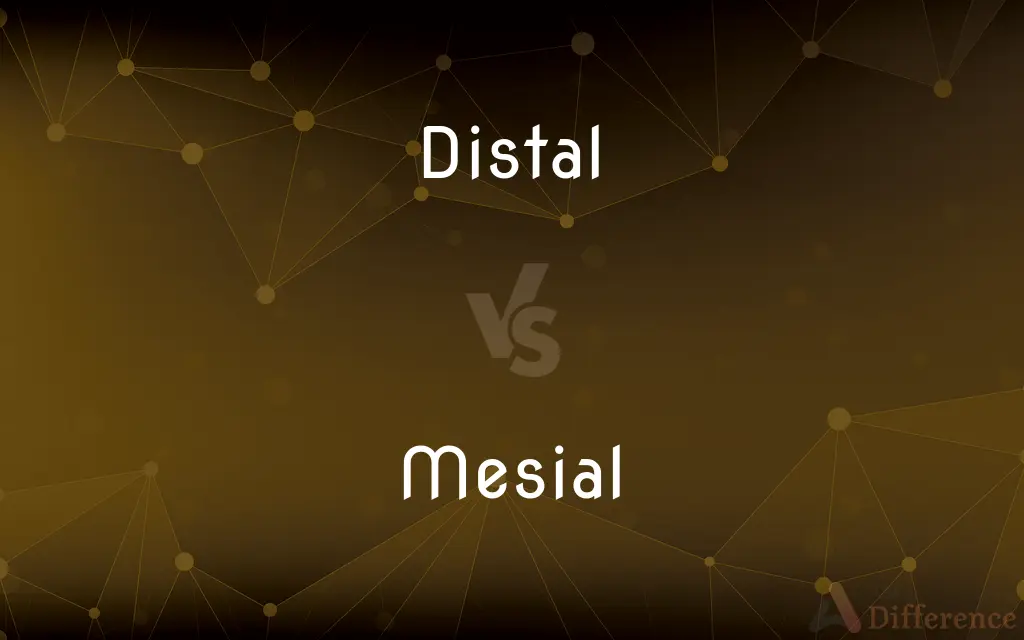Distal vs. Mesial — What's the Difference?
Edited by Tayyaba Rehman — By Fiza Rafique — Updated on April 18, 2024
Distal refers to a position farther from the center of the body or point of attachment, while mesial denotes a position closer to the midline of the body or point of reference.

Difference Between Distal and Mesial
Table of Contents
ADVERTISEMENT
Key Differences
Distal is a term used in anatomy to describe locations on the body that are further from the trunk or nearer to the extremities, whereas mesial generally describes areas that are closer to the midline of the body or dental arch. For instance, the fingers are distal to the wrist, while the teeth towards the center of the dental arch are considered mesial.
In dental terminology, distal surfaces of teeth point towards the back of the mouth, on the other hand, mesial surfaces face towards the front. This distinction helps in identifying the orientation and location of teeth within the dental arch.
The concept of distal can also apply to other structures, such as bones or limbs, indicating a position away from the point of origin or attachment. In contrast, mesial often specifically relates to the teeth and occasionally to other structures, emphasizing proximity to the central axis of the body or an organ.
In medical contexts, understanding distal and mesial is crucial for accurate descriptions of injuries, pathologies, or surgical procedures. Mesial movements or shifts often refer to movements towards the midline, while distal movements imply moving away from it.
Distal is also utilized in other scientific fields, like biology, to describe phenomena or structures that are comparatively farther from a specific reference point. Meanwhile, mesial remains predominantly used within dental and occasionally medical fields, highlighting its specialized usage.
ADVERTISEMENT
Comparison Chart
Definition
Farther from the center
Closer to the midline
Usage in Anatomy
Pertains to limbs, bones
Often pertains to teeth, rarely limbs
Direction in Dentistry
Towards the back of the mouth
Towards the front of the mouth
Relative Position
Away from the point of attachment
Towards the central axis of the body
Common Fields of Usage
Broader medical and biological
Mainly dental, specific medical contexts
Compare with Definitions
Distal
Pertaining to the outer areas of a limb.
Distal muscles in the forearm control wrist and finger movements.
Mesial
In dental terms, adjacent to the midpoint of the dental arch.
The mesial edge of a tooth is crucial for a proper bite.
Distal
Farther from the center of the body.
The toes are located at the distal end of the foot.
Mesial
Rarely used outside of dentistry, sometimes in general medical contexts.
Mesial movement of a limb is toward the body’s center.
Distal
Used to describe remote locations in comparative contexts.
The distal part of the branch is the weakest.
Mesial
Situated toward the midline of the body.
The mesial surface of the incisor faces the center of the mouth.
Distal
In biology, situated away from the point of reference.
The distal segments of a spider’s legs are vital for mobility.
Mesial
Specific to describing dental orientation.
Dentists check for cavities in both distal and mesial surfaces of teeth.
Distal
Located away from the point of attachment.
The distal end of the femur connects to the knee.
Mesial
Closer to the front of the dental arch.
Plaque tends to accumulate on the mesial surfaces of molars.
Distal
Situated away from the centre of the body or from the point of attachment
The distal end of the tibia
Mesial
Of, in, near, or toward the middle.
Distal
Anatomically located far from a point of reference, such as an origin or a point of attachment.
Mesial
(Dentistry) Situated toward the middle of the front of the jaw along the curve of the dental arch.
Distal
Situated farthest from the middle and front of the jaw, as a tooth or tooth surface.
Mesial
(anatomy) Pertaining to the midline of the body.
Distal
Remote from the point of attachment or origin.
The distal end of a bone or muscle
Mesial
(dentistry) Facing the side of a tooth which faces the middle of the jaw.
Distal
(dentistry) Facing the wisdom tooth or temporomandibular joint on the same side of the jaw.
Mesial
Middle; median; in, or in the region of, the mesial plane; internal; - opposed to lateral.
Distal
(linguistics) Far or farther from the speaker.
Mesial
Being in or directed toward the midline or mesial plane of the body
Distal
Remote from the point of attachment or origin; as, the distal end of a bone or muscle
Distal
Situated farthest from point of attachment or origin, as of a limb or bone
Distal
Directed away from the midline or mesial plane of the body
Common Curiosities
Can mesial be used to describe parts of the body other than teeth?
Yes, though rare, mesial can be used to describe other parts of the body, particularly when referring to a position closer to the midline of the body.
What is the opposite of distal?
The opposite of distal is proximal, which means nearer to the center of the body or the point of attachment.
Why is it important to know distal and mesial in anatomy?
Knowing distal and mesial helps in accurately describing the locations of structures or symptoms, which is crucial for diagnosis, treatment planning, and communication in healthcare.
How does the concept of distal apply to limb movement?
Distal describes movements or positions of the limbs that are away from the torso, important in fields like physical therapy and orthopedics.
Do distal and mesial apply to all animals or just humans?
These terms are used across various animals, especially in vertebrates, to describe anatomical orientations similar to their usage in human anatomy.
How does the concept of mesial apply in orthodontics?
In orthodontics, mesial refers to the movement of teeth toward the central line of the dental arch, which is important for correcting alignment.
Is there a specific way to remember the difference between distal and mesial?
A simple way to remember is that distal means 'distance' from the body's center, whereas mesial is 'middle' closer to the midline.
Can distal and mesial be used interchangeably with anterior and posterior?
No, distal and mesial are not interchangeable with anterior (front) and posterior (back), as they describe different aspects of position and orientation.
What does distal mean in relation to the fingers?
Distal in relation to the fingers refers to parts of the fingers that are farther from the hand or closer to the tips.
What practical applications do distal and mesial have in surgery?
In surgery, these terms are used to describe the locations of incisions, implants, or pathologies relative to a central point or midline, critical for accurate interventions.
What role do distal and mesial play in neurology?
In neurology, distal and mesial terms might be used to describe nerve damage or the location of lesions in relation to the central nervous system.
What does distal mean in the context of a disease spread?
In the context of disease spread, distal can refer to the transmission or progression of a disease away from its original site.
How do distal and mesial help in describing dental procedures?
These terms help dentists describe where on a tooth a procedure is performed, such as fillings or crowns, ensuring precise treatment and documentation.
How might a dentist use the terms distal and mesial in patient communication?
A dentist might use these terms to explain where a cavity is located on a tooth or where orthodontic work is needed, helping patients understand treatment areas.
Are distal and mesial relevant in digital imaging modalities?
Yes, in imaging modalities like MRI or CT scans, these terms help describe the precise location of structures or abnormalities in relation to the body.
Share Your Discovery

Previous Comparison
Lack vs. Shortage
Next Comparison
Sandwich vs. BurgerAuthor Spotlight
Written by
Fiza RafiqueFiza Rafique is a skilled content writer at AskDifference.com, where she meticulously refines and enhances written pieces. Drawing from her vast editorial expertise, Fiza ensures clarity, accuracy, and precision in every article. Passionate about language, she continually seeks to elevate the quality of content for readers worldwide.
Edited by
Tayyaba RehmanTayyaba Rehman is a distinguished writer, currently serving as a primary contributor to askdifference.com. As a researcher in semantics and etymology, Tayyaba's passion for the complexity of languages and their distinctions has found a perfect home on the platform. Tayyaba delves into the intricacies of language, distinguishing between commonly confused words and phrases, thereby providing clarity for readers worldwide.
















































